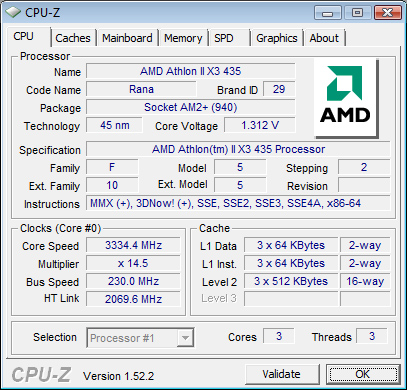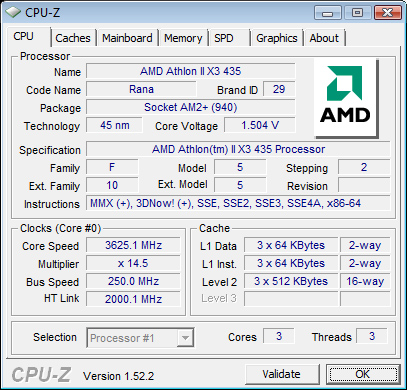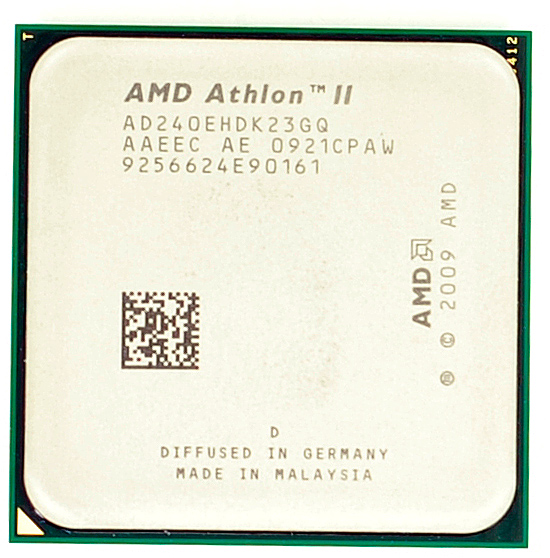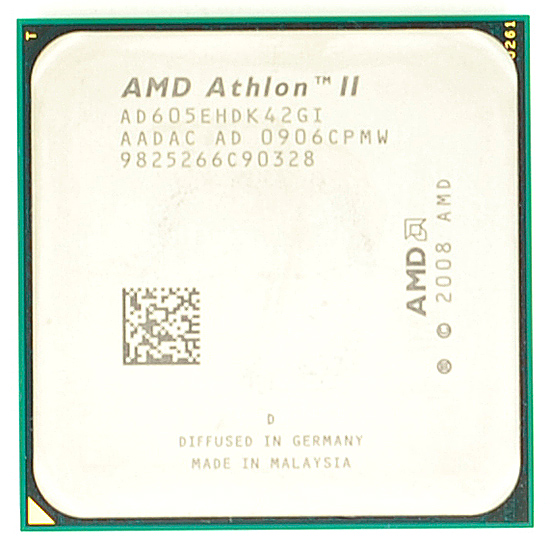AMD's Athlon II X3 435 & New Energy Efficient CPUs: Killing Intel Below $90
by Anand Lal Shimpi on October 20, 2009 12:00 AM EST- Posted in
- CPUs
A month ago AMD introduced the world’s first quad-core processor to debut at $99. Last week, AMD announced its third quarter earnings for 2009. While the company as a whole lost money, the Product Company (CPU and GPU design) turned a small profit. I don’t want to say that the worst is behind AMD, but things are definitely looking up.
| Income | Q3 2009 | Q2 2009 | Q1 2009 |
| AMD | -$128 Million | -$330 Million | -$416 Million |
| AMD Product Company | +$2 Million | -$244 Million | -$308 Million |
And for the consumer, AMD is providing a ton of value these days. You're getting more transistors per dollar than Intel will give you, and it's not just bloat, these things are fast:
| Processor | Cores | Manufacturing Process | L1 Cache | L2 Cache | L3 Cache | Die Size | Transistor Count |
| AMD Phenom II X4 | 4 | 45nm | 128KB per core | 512KB per core | 6MB | 258 mm2 | 758M |
| AMD Athlon II X4/X3 | 4 | 45nm | 128KB per core | 512KB per core | 0MB | 169 mm2 | 300M |
| AMD Athlon II X2 | 2 | 45nm | 128KB per core | 1MB per core | 0MB | 117 mm2 | 234M |
| Intel Core 2 Quad Q8xxx | 4 | 45nm | 64KB per core | 4MB | 0MB | 164 mm2 | 456M |
| Intel Pentium E6xxx | 2 | 45nm | 64KB per core | 2MB | 0MB | 82 mm2 | 228M |
The value train continues with todays introduction of the first triple core Athlon II processors: the Athlon II X3 435 and 425. Clocked at 2.9GHz and 2.7GHz respectively, these processors are simply Athlon II X4s with one core disabled.

They’re also quite affordable. The 435 will set you back $87 while the 425 costs $76. This puts them on par with Intel’s Pentium E6000 series dual core processors, but cheaper than the Core 2 Duo E7500. This has been AMD’s high end dual core strategy for the Phenom’s life: sell three cores for the price of two. And in the past, it has worked.
| Processor | Clock Speed | L2 Cache | L3 Cache | TDP | Price |
| AMD Phenom II X4 965 BE | 3.4GHz | 2MB | 6MB | 140W | $245 |
| AMD Phenom II X4 955 BE | 3.2GHz | 2MB | 6MB | 125W | $245 |
| AMD Phenom II X4 945 | 3.0GHz | 2MB | 6MB | 125W | $225 |
| AMD Phenom II X3 720 BE | 2.8GHz | 1.5MB | 6MB | 95W | $145 |
| AMD Phenom II X2 550 BE | 3.1GHz | 1MB | 6MB | 80W | $105 |
| AMD Athlon II X4 630 | 2.8GHz | 2MB | 0MB | 95W | $122 |
| AMD Athlon II X4 620 | 2.6GHz | 2MB | 0MB | 95W | $99 |
| AMD Athlon II X3 435 | 2.9GHz | 1.5MB | 0MB | 95W | $87 |
| AMD Athlon II X3 425 | 2.7GHz | 1.5MB | 0MB | 95W | $76 |
| AMD Athlon II X2 250 | 3.0GHz | 2MB | 0MB | 65W | $87 |
| AMD Athlon II X2 245 | 2.9GHz | 2MB | 0MB | 65W | $66 |
| AMD Athlon II X2 240 | 2.8GHz | 2MB | 0MB | 65W | $60 |
The X3s AMD is announcing today are clocked high enough that you still have good performance in single threaded applications, and in those that can take advantage of three cores you’re almost guaranteed to have better performance than the Intel alternative.
The real question you have to ask is whether it makes more sense to spend a little more than get a quad-core processor or not.
The Athlon II X3s are 45nm 95W TDP parts and work in both Socket-AM2+ and Socket-AM3 motherboards. As I mentioned before, these are architecturally identical to the X4s just with one core disabled. That means you get a 512KB L2 per core but no L3 cache.
I’ll spoil the surprise for you here: they’re faster than the equivalently priced Intel CPUs in most cases, but that’s not too surprising.
The Athlon II X3 435 is a bit more overclockable than the X4 620. Without any additional voltage we got 3.25GHz on our 620 sample, but our 435 yielded 3.33GHz:

With an extra ~15% voltage we could get 3.63GHz:

AMD is also introducing a slew of energy efficient Athlon IIs as well. They’re all in the table below:
| Processor | Clock Speed | L2 Cache | TDP | Price | Premium |
| AMD Athlon II X4 605e | 2.3GHz | 2MB | 45W | $143 | +$44 |
| AMD Athlon II X4 600e | 2.2GHz | 2MB | 45W | $133 | +$34 |
| AMD Athlon II X3 405e | 2.3GHz | 1.5MB | 45W | $102 | +$26 |
| AMD Athlon II X3 400e | 2.2GHz | 1.5MB | 45W | $97 | +$21 |
| AMD Athlon II X2 240e | 2.8GHz | 2MB | 45W | $77 | +$17 |
| AMD Athlon II X2 235e | 2.7GHz | 2MB | 45W | $69 | +$9 |
These energy efficient processors are binned for lower voltages and thus have a 45W TDP. Unfortunately you do sacrifice clock speed in some cases as a result. There's also a hefty price premium, at the high end you lose clock speed and pay 44% more for a 45W TDP.


The Test
| Motherboard: | Intel DX58SO (Intel X58) Intel DX48BT2 (Intel X48) Gigabyte GA-MA790FX-UD5P (AMD 790FX) |
| Chipset: | Intel X48 Intel X58 AMD 790FX |
| Chipset Drivers: | Intel 9.1.1.1015 (Intel) AMD Catalyst 8.12 |
| Hard Disk: | Intel X25-M SSD (80GB) |
| Memory: | Qimonda DDR3-1066 4 x 1GB (7-7-7-20) Corsair DDR3-1333 4 x 1GB (7-7-7-20) Patriot Viper DDR3-1333 2 x 2GB (7-7-7-20) |
| Video Card: | eVGA GeForce GTX 280 |
| Video Drivers: | NVIDIA ForceWare 180.43 (Vista64) NVIDIA ForceWare 178.24 (Vista32) |
| Desktop Resolution: | 1920 x 1200 |
| OS: | Windows Vista Ultimate 32-bit (for SYSMark) Windows Vista Ultimate 64-bit |










177 Comments
View All Comments
Fleeb - Tuesday, October 20, 2009 - link
Or maybe, these three are just the same person craving for attention in real life he cannot have. Do not hate the guy. Pity him.mapesdhs - Tuesday, October 20, 2009 - link
Sorry for the double post! The submission form just gave an error
the first time round, but I guess it went through anyway. Anand,
please feel free to delete this post and my previous duplicate.
Ian.
mapesdhs - Tuesday, October 20, 2009 - link
Anand, just curious, the test platform description includes mention
of an X58 mbd, yet there are no i7 results in the tables. How come?
Then again, including a couple of data points from a P55 with an
i5 750 and i7 860 would be more useful. AMD wins on price by a mile
of course (personally I reckon the 620 is the best buy much of the
time) but for those occasions where only 1 or 2 threads are running,
the i5 750 might win on price/performance. If it's deemed appropriate
to include a top-end Ph2 in the results, then surely at the very
least the i5 750 should have been included aswell just to put things
into perspective? I would include an 860 aswell just to show where
the curves are heading on the Intel side, but nothing above that.
And btw no, I don't agree with anything maddoctor says. Speaking of
which, can you please ban the guy? Once again the discussion section
of an otherwise interesting article is just being filled up with
junk. To everyone else: please don't reply to his posts, you're just
making it worse. It's a sad fact of nature that half the population
have got to be below average. Who _are_ these people? Sheesh, I can
almost hear the banjo, da da ding ding ding... :D
Ian.
PS. One other thing Anand, have you ever tested how high the 620
can be oc'd with a *good* air cooler? I know the retail AMD cooler
allows it to reach 3.25, but what about with something better? Someone
mentioned the Coolermaster Hyper TX2 as being a suitable alternative.
rupa - Tuesday, October 20, 2009 - link
hi ... my 620 is stable till 3.380 (260x13) - noctua nh-u12p default vcore x64 asus m3a78tmapesdhs - Tuesday, October 20, 2009 - link
Anand, just curious, the test platform description includes mention
of an X58 mbd, yet there are no i7 results in the tables. How come?
Then again, including a couple of data points from a P55 with an
i5 750 and i7 860 would be more useful. AMD wins on price by a mile
of course (personally I reckon the 620 is the best buy much of the
time) but for those occasions where only 1 or 2 threads are running,
the i5 750 might win on price/performance. If it's deemed appropriate
to include a top-end Ph2 in the results, then surely at the very
least the i5 750 should have been included aswell just to put things
into perspective? I would include an 860 aswell just to show where
the curves are heading on the Intel side, but nothing above that.
And btw no, I don't agree with anything maddoctor says. Speaking of
which, can you please ban the guy? Once again the discussion section
of an otherwise interesting article is just being filled up with
junk. To everyone else: please don't reply to his posts, you're just
making it worse. It's a sad fact of nature that half the population
have got to be below average. Who _are_ these people? Sheesh, I can
almost hear the banjo, da da ding ding ding... :D
Ian.
PS. One other thing Anand, have you ever tested how high the 620
can be oc'd with a *good* air cooler? I know the retail AMD cooler
allows it to reach 3.25, but what about with something better? Someone
mentioned the Coolermaster Hyper TX2 as being a suitable alternative.
Zool - Tuesday, October 20, 2009 - link
For a fast compare with other procesors the test setup is not bad but for some people some the benchmarks could be misleading.People will not buy these cpu-s just to put them together with a intel SSD drive and a gtx280.
I think it wouldnt take much longer to test it with average hdd and a sub 100$ gpu. I would care much less if i cant compare it to other anad tests with high end cpus.
Zool - Tuesday, October 20, 2009 - link
For a fast compare with other procesors the test setup is not bad but for some people some the benchmarks could be misleading.People will not buy these cpu-s just to put them together with a intel SSD drive and a gtx280.
I think it wouldnt take much longer to test it with average hdd and a sub 100$ gpu. I would care much less if i cant compare it to other anad tests with high end cpus.
7Enigma - Tuesday, October 20, 2009 - link
Zool,The purpose of using an SSD is strictly for the variability between tests. What Anand's site never shows (and one of my major complaints) is % error. In any statistical measurement you always present the amount of error in a test. What this might show is there is no REAL clear winner, or very little difference as when you get close (say within 5%), and you have a large variability (say due to a standard HD or run-to-run variability), the numbers become moot.
I will agree with you on the GTX280, however, as that is a pointless component for this price sector.
7Enigma - Tuesday, October 20, 2009 - link
As an example I went back and looked at the game data. The Fallout3 data is generated MANUALLY by running through an area and using FRAPS. The X2/X3 chips are bunched up with less than 1 fps between them. I would wager a hefty sum that the % error in this test is greater than 1fps and so any chips within that range are EQUAL. Same goes for Left 4 Dead...maddoctor - Tuesday, October 20, 2009 - link
I don't see anything wrong for the benchmark setup, but other SSD products are not competitive and have lower performance than Intel products. The most wrong thing about is Anand is compare AMD rubbish product to Intel products.